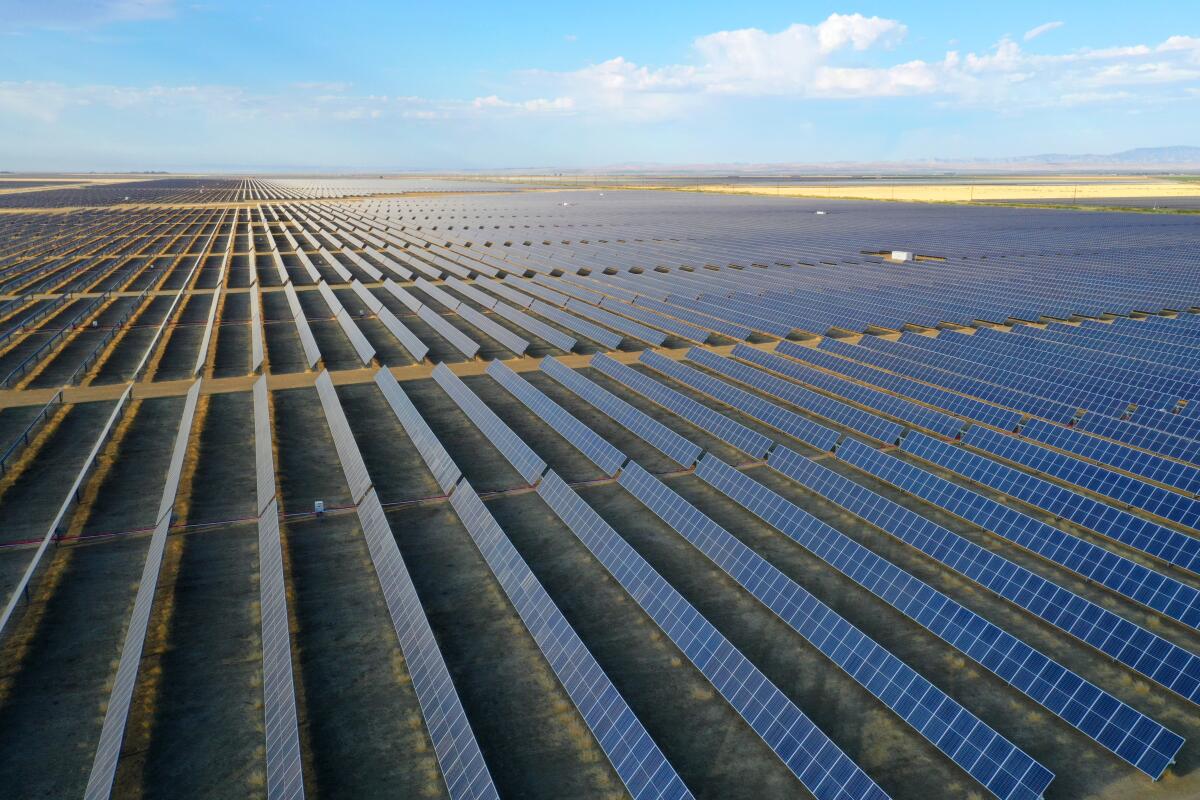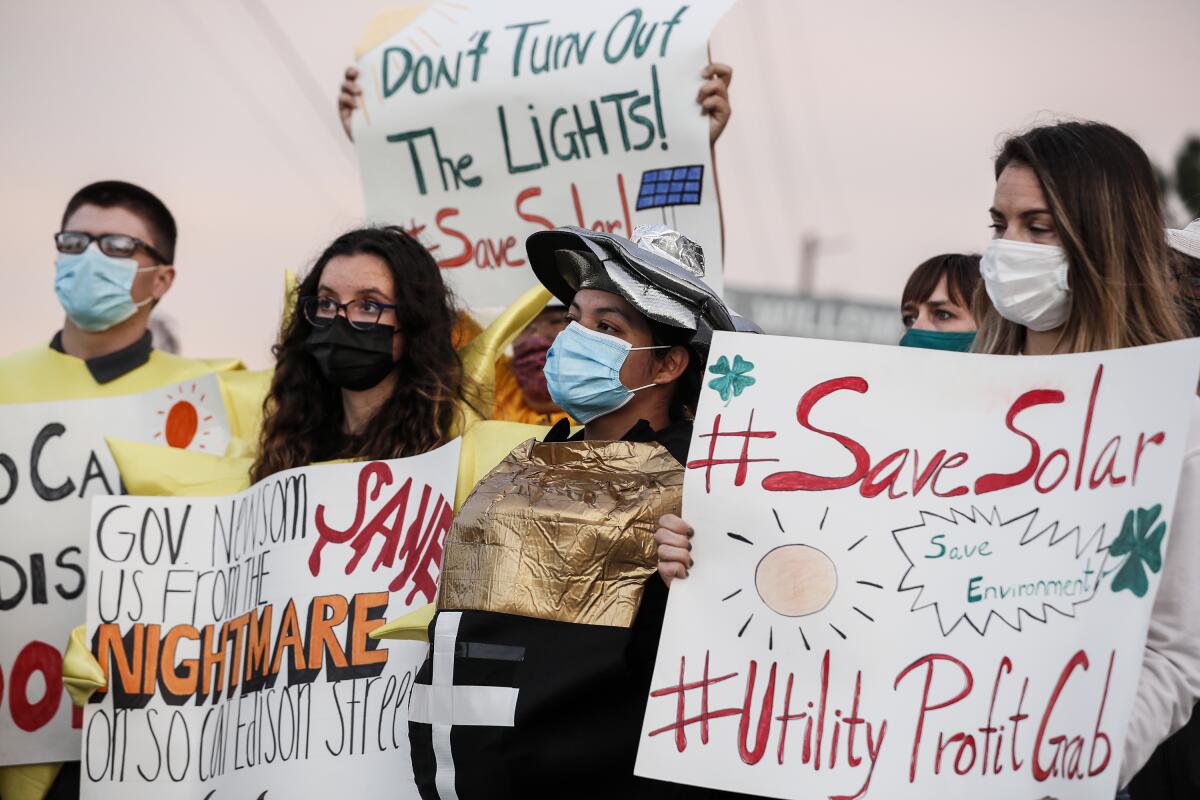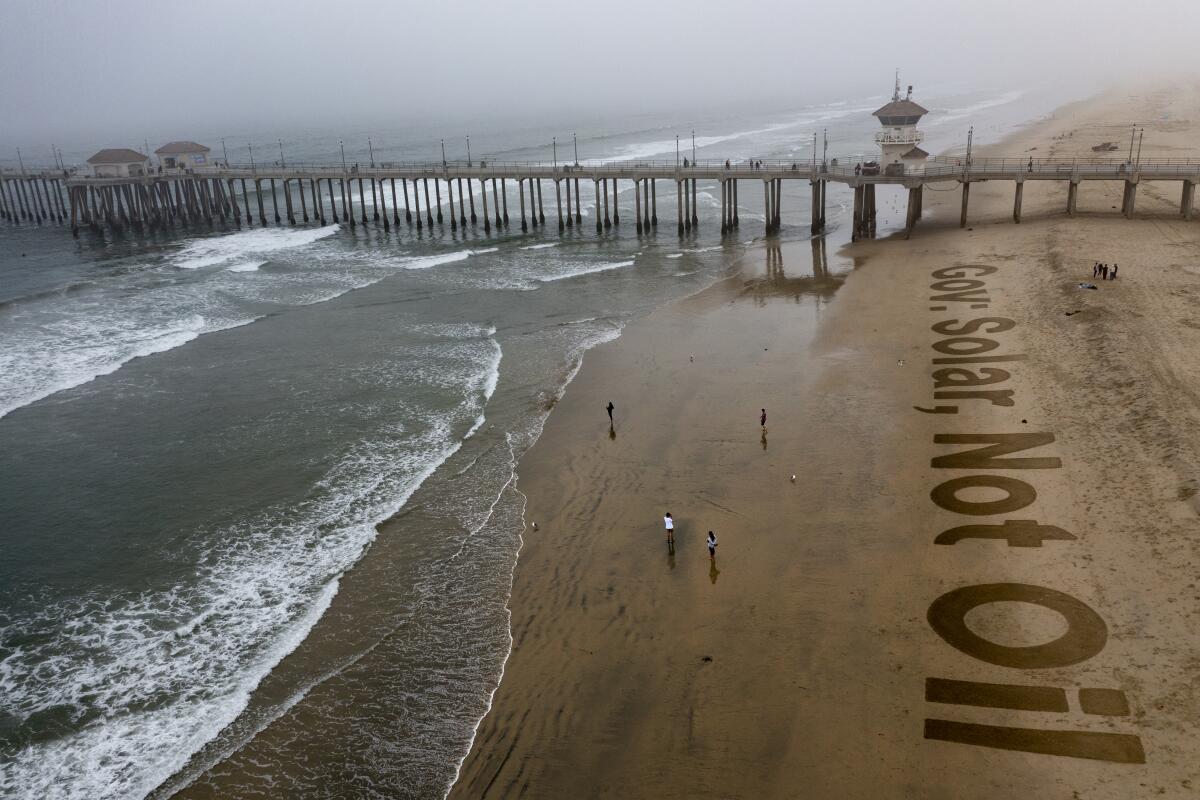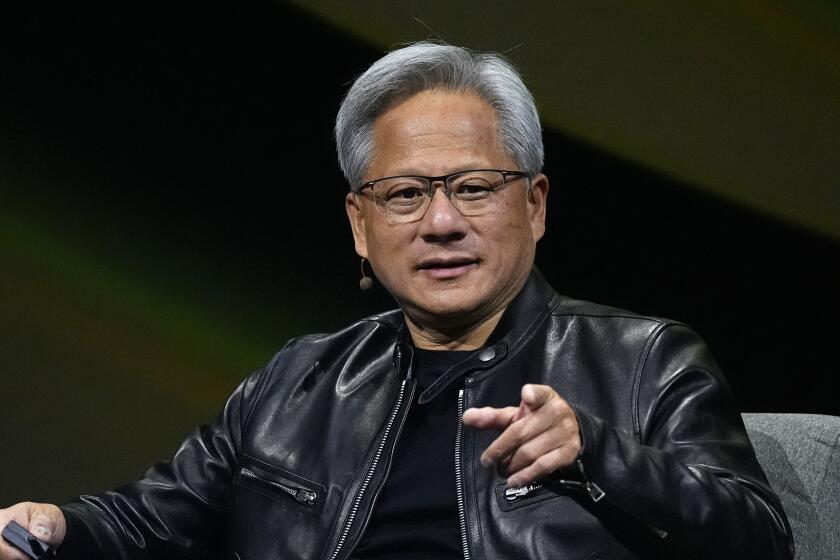California proposes big changes to rooftop solar incentives

California officials want to slash payments for rooftop solar power, saying the changes would help the state achieve 100% clean energy while keeping the lights on, preventing electricity rates from rising and encouraging people to install batteries.
But solar executives are furious with the changes, saying they would backfire and crater a thriving industry.
The proposal from Martha Guzman Aceves, one of five members of the California Public Utilities Commission, would revamp an incentive program called net energy metering that has helped the state become a national solar power leader, with more than 1.3 million rooftop and other small-scale systems installed. The solar industry and climate change advocacy groups are lobbying Gov. Gavin Newsom and his appointees on the utilities commission to keep the program’s basic tenets unchanged.
Toward a more sustainable California
Get Boiling Point, our newsletter exploring climate change, energy and the environment, and become part of the conversation — and the solution.
You may occasionally receive promotional content from the Los Angeles Times.
In an interview, Guzman Aceves said net metering needs to evolve to reflect California’s changing energy needs. The Golden State’s power grid is increasingly flooded by solar energy during the afternoon but strained on hot summer evenings, when millions of people throttle up their air conditioners to cope with high temperatures made worse by the climate crisis.
Reducing demand for planet-warming fossil fuels such as diesel and natural gas during that “net peak” period in the evening, Guzman Aceves said, is her overriding goal.
She and her staff crafted a plan to phase out net metering that will encourage new and existing solar customers to add battery storage systems that can bank clean energy for after dark, she said. Among other provisions, a new “storage evolution fund” would offer payments for homes that already have solar panels to add storage.
“There’s a huge opportunity here for us to get more out of these customers to contribute to the net peak,” Guzman Aceves said.
Other elements of the commissioner’s proposal would prompt Californians to switch from gasoline to electric vehicles, and from natural gas furnaces and stoves to electric appliances fueled by solar and wind energy, Guzman Aceves said — key pieces of California’s war on climate change. For instance, homes and businesses that add solar panels would be allowed to build much bigger systems than is currently allowed under net metering, to support lifestyles that are increasingly powered by electricity.
“I think the proposal is strong,” Guzman Aceves said. “It’s focused on what we collectively need, to get off of fossil fuels.”

Solar executives and climate activists, though, said the proposal would only impede California’s aggressive climate goals.
Walker Wright, vice president of public policy at San Francisco-based Sunrun, the nation’s largest rooftop solar installer, was similarly displeased, saying in a written statement that Guzman Aceves’ proposal would “impose the highest discriminatory charges on solar and energy storage customers in the U.S., putting rooftop solar and batteries out of reach for countless families.”
Wright also said the proposed changes are “contrary to the state’s objectives of addressing climate change and eliminating frequent blackouts” — a reference to the utility industry’s practice of shutting down the electric grid in certain places during dry, windy conditions to prevent wildfire ignitions. Solar supporters see those “public safety power shutoffs” as a powerful argument for encouraging rooftop systems paired with batteries that can serve as a backup power source when the grid goes down.
“Only the wealthiest Californians will be able to afford rooftop solar, shutting out schools, small businesses, and the average family from our clean energy future,” said Abigail Ross Hopper, president of the Solar Energy Industries Assn., a trade group, in a written statement. “The only winners today are the utilities, which will make more profits at the expense of their ratepayers.”
Guzman Aceves’ proposed decision, which was released Monday, endorses the argument made by the state’s largest investor-owned utility companies — Southern California Edison, Pacific Gas & Electric and Sempra Energy — that net metering subsidizes richer households that can afford rooftop solar at the expense of lower-income households that can’t.
The utilities estimate that “cost shift” at $3.4 billion annually, a figure hotly disputed by the solar industry and climate activists, who say rooftop panels create many public benefits that aren’t included in the calculation, including the health benefits of less air pollution from fossil fuels and the cost savings from limiting the need for new power plants and transmission lines. Rooftop solar also doesn’t require paving over undisturbed land, unlike sprawling desert solar farms that can tear up sensitive ecosystems.
Clean energy activists and utility giants are duking it out over the future of rooftop solar.
Utility companies have led the charge for lower rooftop solar incentives, alongside politically powerful labor unions representing their employees, who have a vested interest in protecting the monopoly utility business model. But they’re not alone.
Two influential consumer watchdog groups, the Utility Reform Network and the state’s Public Advocates Office, have joined the utilities in arguing for reduced incentives for rooftop solar. A handful of prominent environmental groups, including the Natural Resources Defense Council and the California Environmental Justice Alliance, have also argued the program is not equitable.
Mohit Chhabra, a senior scientist at NRDC, called the proposed decision “a strong North Star.” He was especially pleased with a plan to spend $600 million over four years to bring clean energy to low-income and polluted neighborhoods, possibly through incentives for batteries or locally built “community solar” facilities that serve households unable to install their own solar.
The Utility Reform Network praised the commissioner’s proposal, too, with staff attorney Matthew Freedman describing it as “a step in the right direction” that prioritizes low-income households “who have been left behind under the current program.”
Southern California Edison offered similar praise, calling the decision “a meaningful step toward modernizing California’s rooftop solar program” that will “reduce the financial burden on non-solar customers who have subsidized net energy metering.”

Guzman Aceves thinks the $3-billion cost shift estimate is “on the low side” of what non-solar ratepayers are actually paying for net metering. If, instead, the state were to spend the same amount building large solar farms in the desert or on retired farmland — which generate electricity more cheaply than rooftop systems because of economies of scale — it could triple its solar capacity, a comparison that helps illustrate “how much we’re spending and how much we’re getting” from the rooftop program, Guzman Aceves said.
The commissioner wants to make several substantial changes to net metering.
First, she would slash the payments that newly enrolled solar customers receive for the electricity they send to the power grid when their systems generate more than they need. Instead of being compensated at the retail rate — the same rate they pay for electricity from the grid — they would be paid at a much lower rate known as the “avoided cost.” That would amount to about 5 cents per kilowatt-hour of electricity, down from 20 to 30 cents today, according to the California Solar & Storage Assn.
Second, new solar customers would pay a monthly “grid participation charge” of $8 per kilowatt of solar power per month to help cover the costs of maintaining the grid, such as utility safety projects to reduce the risk of wildfire ignitions. Net metering critics say that type of “fixed charge” can ensure that crucial utility expenditures aren’t just paid for by lower-income households.
A home with a six-kilowatt system would be charged $48 a month, or $576 a year. Low-income homes would be exempt.
The proposed decision responds to concerns raised by solar companies — namely, that reducing net metering payment and adding monthly fees would crash the solar market — by creating a “market transition credit” of up to $5.25 per kilowatt per month for homes that add solar panels within four years of the new program taking effect. The size of the available credit would drop each of those four years, but customers who add solar — with or without batteries — would lock in the savings for a decade.
Guzman Aceves said the credits are designed to create a “payback period” of 10 years for new solar customers, meaning that’s how long it would take them to make back their upfront investment through lower electric bills. Payback periods currently hover around five years. The utility companies had proposed net metering changes that could increase them to roughly 20 years.
Guzman Aceves described targeting a 10-year payback period as a judgment call.
“I personally know that for some of my expenses, I recently put in a water heater, and that has a 10-year payback,” she said.
Organized labor wants to make it harder for rooftop solar companies to install batteries.
Solar executives, though, aren’t convinced the commissioner’s proposal would actually result in 10-year paybacks — and even if it did, they say, that’s far longer than the seven years or less that is needed to persuade most people to invest in solar.
Bernadette Del Chiaro, executive director of the California Solar & Storage Assn., an industry trade group, said in an email that she was “shocked at how bad” the proposed decision is. The idea that it’s pro-batteries, she said, “couldn’t be further from the truth,” with new monthly fees applying to all solar-powered homes and businesses, whether or not they have energy storage.

Del Chiaro also pointed out that many of the changes could take effect as soon as May. She said that’s not nearly enough time for the industry to reorient itself around energy storage, especially with just 15% of homes going solar today adding a battery.
“How in the world are we supposed to sell, not to mention manufacture and distribute, that many batteries in that period of time?” she asked. “We need to ramp up the battery market, but making solar more expensive in the next five months is how you kill the entire distributed generation market, not how you drive a storage market.”
Labor unions, climate activists and monopoly utilities are scrambling to shape the clean energy transition.
Homes and businesses that already have solar would be switched from net metering to the new “net billing” program envisioned by Guzman Aceves 15 years after their systems were installed. She suggested that should give those solar customers — who data show are wealthier and whiter than the state as a whole — more than enough time to make back their investments.
Existing solar customers that switch to the new program — as well as new solar customers — would also pay higher rates for power from the grid during times when the utility system is strained, such as hot summer evenings, and lower rates at other times.
All utility customers are currently shifting to those “time of use” rates, whether or not they have solar. But under Guzman Aceves’ proposal, the difference between “peak” and “off peak” charges would be even greater for solar homes, to prompt them to add batteries that could store cheap electricity during the day and discharge in the evening, reducing strain on the grid. These types of rates also work well for people with electric cars to charge or homes heated and cooled by electric heat pumps, supporters say.
The proposed decision would only affect customers of Edison, PG&E and Sempra subsidiary San Diego Gas & Electric. Customers of publicly owned utilities such as the Los Angeles Department of Water and Power wouldn’t see their solar incentives change.
The earliest the Public Utilities Commission could vote on the proposal would be Jan. 27, after a public comment period.
Support our journalism
Your support helps us deliver the news that matters most. Subscribe to the Los Angeles Times.
By then the agency will have a new president, with Marybel Batjer stepping down and being replaced by Newsom’s energy advisor, Alice Reynolds, on Dec, 31. Guzman Aceves will also be leaving the commission at the end of this week, after being appointed by President Biden to lead the southwestern region of the U.S. Environmental Protection Agency.
Especially if Newsom moves quickly to replace Guzman Aceves, he could have a lot of sway over the final decision — if he wants to.
But solar advocates might find themselves disappointed. Responding to questions from The Times, Newsom spokesperson Erin Mellon said only that the governor “does not direct independent boards or individuals on how to handle any issues that are in front of them.”
That’s despite solar companies and climate advocacy groups lobbying the governor to push the commission in their direction.
The Save California Solar campaign, which includes more than 600 organizations, says it delivered 120,000 public comments supportive of net metering to Newsom last week. The campaign estimated Monday that even after the “market transition” credits proposed by Guzman Aceves, the commissioner’s plan would add $57 per month to the bill paid by the average solar-powered home.
Laura Deehan, who leads the advocacy group Environment California, compared the proposal to “the equivalent of tying cement blocks to our ankles as we race to transition away from fossil fuels,” saying it would derail California’s path to 100% clean energy.
“That path requires a sustained commitment to growing rooftop solar,” Deehan said in a written statement. “The momentum that rooftop solar has now would help us reach our goal — but to gut net metering is to gut that momentum.”

The utility industry and its allies have sought to frame net metering as unfair subsidy helping the rich at the expense of the poor, and whiter communities at the expense of people of color. The solar industry counters that the technology is reaching more people as it gets cheaper.
Data from Lawrence Berkeley National Laboratory show that 12% of California solar adopters in 2019 had incomes below $50,000, and an additional 29% had incomes between $50,000 and $100,000, up from 9% and 24%, respectively, a decade earlier.
The Affordable Clean Energy for All campaign, which lists more than 100 diverse supporters but whose sole funders are the utility companies, issued a statement from spokesperson Kathy Fairbanks saying the proposed decision “recognizes we can grow rooftop solar in California while taking steps to reduce inflated subsidies that have put an unfair cost burden on renters, seniors, disadvantaged communities and other working Californians who don’t have the ability or means to install rooftop solar systems.”
Fairbanks estimated that homes that don’t have solar are currently paying $245 a year to subsidize those that do.
The Save California Solar campaign, meanwhile, released a statement from Pastor William Smart Jr., president of the Southern Christian Leadership Conference, who described the Public Utilities Commission’s proposed decision as a “utility profit grab,” saying it would “take California back to a time when solar was a luxury for the wealthy and out of reach for our communities.”
“It is a story as old as this country: A new technology is developed, programs and policies are offered to help consumers to adopt the technology and bring down the costs over time, and just when people in Black and brown communities are beginning to be able to afford the technology and benefit from it — the programs and policies are often taken away,” Smart said.
More to Read
Inside the business of entertainment
The Wide Shot brings you news, analysis and insights on everything from streaming wars to production — and what it all means for the future.
You may occasionally receive promotional content from the Los Angeles Times.














